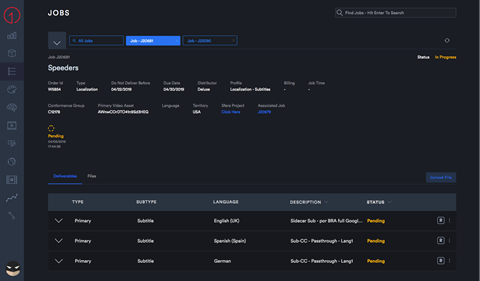The growth in OTT platforms has boosted demand for the localisation and regionalisation of content. And the cloud is proving to be a terrific enabler, writes David Davies.

These are – to put it mildly – dynamic days for live broadcast production.
Thanks in particular to the dramatic increase in the number and diversity of OTT platforms, the need to customise content with local elements has become significantly more acute – as has the requirement for this to be undertaken with as little an impact as possible on often already overstretched production teams.
With its huge potential audiences and commercial opportunities, it is sports that places the greatest demands upon localisation. For broadcasters and rights holders, it is only through effective and seamless localisation that advertising income can be optimised across devices and territories.
Writing on its website, cloud-based media solutions provider M2A Media neatly encapsulates recent developments around localisation:
“In traditional linear broadcast, localisation of a live event is usually designed around a linked set of playout systems using a single source that is localised during breaks by running multiple playlists in parallel. More recently, the OTT world has adopted various Server Side Ad Insertion (SSAI) and Dynamic Ad Insertion (DAI) technologies that rely on the same mechanisms that were originally developed for localising live broadcasts in playout.”
- Read more: Inside Netflix’s post production operation
With broadcaster demands of localisation both growing and remaining the subject of considerable variation, it’s hardly surprising that this is becoming an extremely competitive sector.
Serving customised content
Evolving expectations of localisation mean that adopting a cloud-based solution is often the only practical way forward, says M2A Media solutions architect Valentijn Siebrands. “For a start the cloud provides much more flexibility,” he says. “It also makes it far easier to implement more frequent incremental updates that can bring additional functionality. Then there are some [newer] functionalities - such as SSAI – that can really only be done in the cloud. It’s not possible with hardware equipment in the racks.”

At present, there are several primary strands to demand for M2A’s cloud solutions. On one hand, says Siebrands, “there are the broadcasters who want to be able to focus more on content and who don’t necessarily have the engineering skills to [undertake cloud-based activities themselves].” Consequently, they want to be able to farm out this part of the operation to a cloud specialist.
Then there is the rising tide of enquiries from sports rights holders who would historically have “gone through local or regional TV stations. It’s either the case that the stations cannot offer enough money [for the rights], or that they see a stronger user case in going to the consumer directly – which is where they need a service company such as M2A.”
Both in terms of traditional broadcaster workflows and rights holder-directed operations, ad insertion is now “one of the biggest drivers” of localisation.
“What might have been done once in broadcast data centres is now more logically geared towards the cloud because broadcasters need to be able to scale up [as requirements change],” says Siebrands.
To this end, M2A Media introduced its Dynamic Content Insertion (DCI) product at IBC 2018. The M2A DCI solution allows broadcasters and OTT content publishers to serve customised content – be it adverts, promos, subtitles or audio – to different viewers depending on where they are in the world. The new product is designed to be integrated server-side, enabling a seamless transition between broadcast and embedded content. This yields a single stream that can be deployed across all devices, including set-top boxes, mobiles and tablets.
The benefits of implementing DCI, says Siebrands, include “greater monetisation and localisation of content, [as well as] streamlined production and the reduction of overheads.”
Different requirements, different methods
Deluxe is another cloud-based solution provider that has been well-placed to track the evolution of localisation in recent years. Chris Reynolds, SVP of localisation products and services at Deluxe, remarks that “nearly all localisation service providers have moved to the cloud and are taking advantage of it to some degree – but not all have adopted it to the same extent.”

Reynolds goes on to identify several of the commonly encountered user scenarios. Some users, he remarks, utilise the cloud “for centralised asset storage and delivery. Others leverage it more fully to enable a range of things such as: faster turnaround times; centralised project and asset management; the ability to minimise or eliminate file transfers and asset hand-offs; and access to quickly expanding inventory of localisation technologies that can be utilised to speed up processes and improve quality.”
According to Reynolds these technologies can be applied in different ways and range from speech-to-text and machine translation engines, to text recognition, language recognition, audio processing and image analysis. “One challenge is the initial work of having to rethink workflows and adopt new processes and tools, but it’s well worth the investment,” he says.
The current Deluxe range includes an end-to-end array of creation and distribution products and services, “spanning every aspect of the media ecosystem that broadcasters might need [in order] to localise and distribute content. That includes everything from ingest, QC and transcoding to working with virtually any file format, and we utilise our cloud-based platform, Deluxe One, to provide a truly centralised view of orders and tasks across every step of the process.”

Deluxe currently has more than 9,000 in-region localisation specialists working directly within its platform, as well as an extensive partner network that includes 350-plus dubbing studios “to provide the scale that broadcasters and platforms need to process high volumes of work across a wide range of languages”.
Whilst migration to the cloud will continue to underpin a new generation of services, and accelerate the efficiency of many that already existed, it is widely accepted that the other primary beneficiary will be collaboration. In terms of generating, sharing and repurposing content alone, it holds opportunities whose magnitude is only starting to become clear.
- Read more: Media and the cloud: An overview of adoption
As Reynolds notes, “the cloud provides endless possibilities for innovation, and we expect companies to continue developing and leveraging new tools that will streamline workflows and automate processes. The cloud is designed for collaboration and process improvement, and with the way software is directly integrated into cloud infrastructures it creates infinitely more options to adapt and change processes to constantly improve workflows, speed and quality.”
























No comments yet